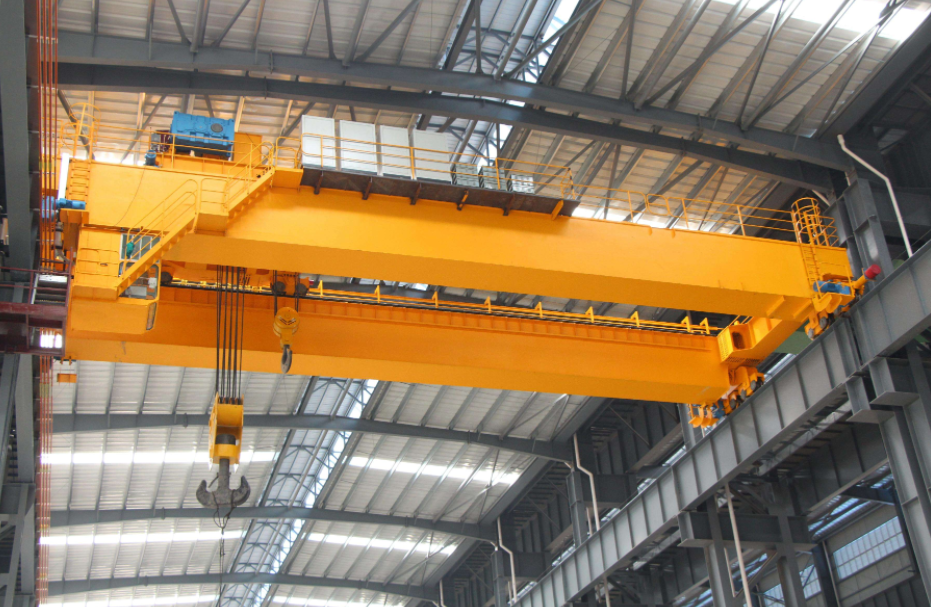What Makes Double Girder Overhead Cranes Different from Single Girder Models?
- blog@ellsenbridgecrane.com
- Jan 5
- 4 min read
Overhead cranes are indispensable in many industries, from manufacturing and warehousing to construction and shipbuilding. Among the various types of overhead cranes, single girder and double girder models are the most common. While they share a fundamental purpose—to lift and transport heavy loads—their differences make them suitable for distinct applications. Understanding these differences is essential for selecting the right crane for your needs. This article delves into the key distinctions between double girder overhead cranes and single girder overhead cranes, focusing on their design, performance, applications, and advantages.

Design and Construction
Single Girder Overhead Cranes
A single girder overhead crane has one main horizontal beam, known as the girder, supported by two end trucks. The hoist is typically mounted underneath the girder, allowing for a simple and compact design. These cranes are lightweight, requiring less material and structural support for installation.
Key features of single girder overhead cranes include:
Simple Construction: With fewer components, single girder cranes are easier to assemble and maintain.
Lightweight Design: Ideal for facilities with limited headroom or lower structural load capacities.
Cost-Effectiveness: Lower material and manufacturing costs make them more affordable than double girder models.

Double Girder Overhead Cranes
Double girder overhead cranes feature two parallel girders that run across the span of the crane. The hoist is mounted on a trolley that travels on rails installed on top of the girders. This design provides greater lifting capacity and stability.
Key features of double girder overhead cranes include:
Robust Construction: Two girders enhance the crane’s strength and durability.
Higher Load Capacity: Capable of handling heavier loads, often exceeding 20 tons.
Increased Stability: The dual-girder design minimizes deflection, even under maximum load.
Lifting Capacity
One of the most significant differences between single girder and double girder overhead cranes lies in their lifting capacities.
Single Girder Cranes: These cranes are typically designed for lighter loads, with capacities ranging from 1 ton to 20 tons. They are suitable for applications that don’t demand heavy-duty lifting, such as assembly lines, light manufacturing, and small warehouses.
Double Girder Cranes: With a higher load capacity, double girder cranes can handle weights exceeding 20 tons, with some models capable of lifting up to 500 tons. This makes them ideal for heavy manufacturing, steel mills, and power plants where large, heavy components need to be moved.
Lifting Height and Span
Single Girder Cranes: The hoist being mounted below the girder limits the maximum lifting height. This makes single girder overhead cranes more suitable for facilities with height restrictions.
Double Girder Cranes: The hoist’s placement on top of the girders allows for a higher lifting height. Additionally, double girder cranes can accommodate wider spans, making them suitable for large facilities and extensive operations.
Installation and Maintenance
Single Girder Cranes: The simpler design of single girder cranes results in faster and more cost-effective installation. They also require less maintenance due to their fewer components.
Double Girder Cranes: These cranes have a more complex design, requiring more time and resources for installation. However, their robust construction often translates to lower long-term maintenance needs, as they are built to withstand rigorous use.
Applications
The choice between single and double girder overhead cranes depends largely on the application and operational requirements:
Single Girder Applications
Light manufacturing
Assembly lines
Small to medium-sized warehouses
Maintenance workshops
Double Girder Applications
Heavy manufacturing
Steel mills
Power plants
Large warehouses and logistics centers
Shipbuilding and marine applications
Cost Considerations
Initial Investment: Single girder cranes are more affordable upfront due to their simpler design and lower material costs.
Long-Term Costs: While double girder cranes require a higher initial investment, they often provide better long-term value in terms of durability, performance, and lower maintenance costs.
Advantages of Each Type
Single Girder Cranes
Affordability: Cost-effective for lighter applications.
Compact Design: Suitable for facilities with height or space constraints.
Ease of Installation: Faster setup with fewer components.
Double Girder Cranes
High Capacity: Ideal for heavy-duty lifting.
Greater Stability: Handles heavier loads with less deflection.
Customizability: Supports advanced features like walkways, maintenance platforms, and auxiliary hoists.
Higher Lifting Height: Optimized for applications requiring greater vertical reach.
Safety Features
Both single and double girder cranes incorporate safety features, but the complexity of double girder cranes often allows for more advanced systems:
Single Girder Cranes: Basic safety mechanisms such as limit switches and overload protection.
Double Girder Cranes: Enhanced features like anti-sway technology, collision avoidance systems, and advanced braking systems.
Conclusion
When deciding between a single girder and double girder overhead crane, it is crucial to consider the specific needs of your operation. Single girder cranes are excellent for light-duty applications where cost and simplicity are priorities. In contrast, double girder cranes are better suited for heavy-duty operations that require high lifting capacities, greater stability, and advanced features.
By understanding the differences between these two crane types, businesses can make informed decisions, ensuring the chosen crane meets their operational requirements efficiently and cost-effectively. Whether you need a compact, budget-friendly solution or a robust, high-capacity crane, both single and double girder models have their unique advantages to offer.








Comments